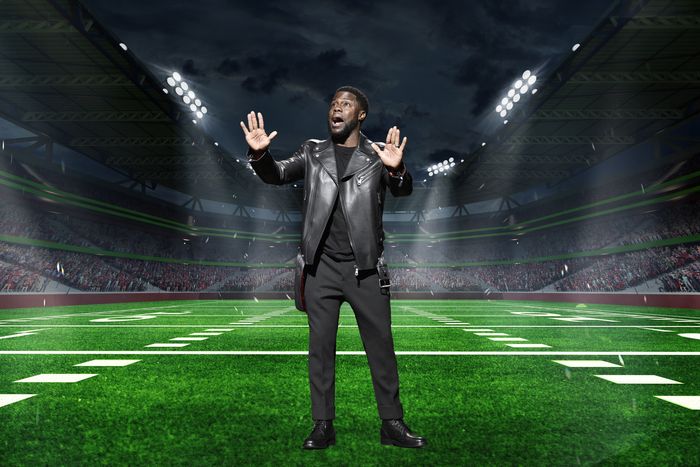
The NFL season is over. The Chiefs have been crowned, again. The 49ers are looking back at what went wrong, again. Supporters of each side are contemplating what their futures hold, again, as they whirl about in the unceasing seasonal cycle of sports fandom. And I don’t care about any of that, again. Instead, I want to talk about the halftime show — the premiere entertainment event of the year, where beloved legends and Maroon 5 showcase the best of their catalogues and the sickest of their roller-skating tricks. Next year, I think that performer should be a comedian.
Our current conception of the Super Bowl halftime show as the exclusive domain of music superstars isn’t that old. For decades, the mid-game break featured forgettable marching-band medleys and generic family-friendly cover acts. The evolution out of that era was clumsy — the 1989 halftime show featured, and this is 100 percent true, an Elvis Presley–impersonating magician named Elvis Presto (cool name) — but in the early ’90s, the halftime-show producers began tapping into modern pop-music sensibilities. In 1991, the New Kids on the Block joined a medley at Super Bowl XXV. A year later, Gloria Estefan participated in a salute to the Winter Olympics, and then in 1993, Michael Jackson fully cemented this new paradigm with a stunning (he teleported) yet still a bit corny (a children’s choir sang “We Are the World”) performance. A few stumbles aside (the 1995 show featured a bizarre Indiana Jones routine that included Tony Bennett and Patti LaBelle cameos), we haven’t looked back since.
We haven’t looked forward, either. Once the halftime-show producers recognized the appeal of booking top pop stars for the gig, they seemed to have settled into that mode. But now, another art form is regularly filling sports venues: comedy. It’s the culmination of years of gradual change. In 1993, you could have counted on one hand, if not one finger, the number of comedians capable of selling out Madison Square Garden. Today, there are too many to list, including Jamie Foxx, Chris Rock, Eddie Izzard, Kevin Hart, Aziz Ansari, Russell Peters, Gabriel Iglesias, Louis C.K., Bill Burr, Jim Gaffigan, Amy Schumer, Sebastian Maniscalco, the Impractical Jokers, Joe Rogan, Trevor Noah, John Mulaney, Jo Koy, Dave Chappelle, Andrew Schultz, and Tony Hinchcliffe, just to name ones who have already done it or are scheduled to do so this year. Audiences are increasingly seeking out comedy in the same venues, and at broadly the same scale, as music.
The idea of bringing that experience to the Big Game isn’t totally without precedent. In 1987, George Burns provided a comic introduction for the Grambling State University and USC Marching Bands when they did the Super Bowl XXI halftime show; ten years later, the Blues Brothers jammed with James Brown and ZZ Top. Those examples suggest the easiest ways to gradually incorporate comedy: via hosting or music. Imagine Jamie Foxx having done some shtick MC-ing the hip-hop–50th-anniversary halftime show two years ago, or Andy Samberg joining Justin Timberlake to perform “Motherlover.” It’s an easy way to prove the concept without requiring the comedian to shoulder too much of the load.
Eventually, if halftime is to be fully devoted to a comedy set, we’ll need someone with experience performing in the largest venues. While halftime shows are produced primarily with the at-home viewing audience in mind — an aspect stand-up would simplify since comics probably won’t be moving around the stadium or doing elaborate dance routines — you still need a comedian who’s comfortable in that sort of environment. It takes a certain skill set to command and keep the attention of tens of thousands of people in a noisy football stadium. Larry the Cable Guy performed for more than 50,000 fans at the University of Nebraska’s football stadium in 2009, and Kevin Hart played Philadelphia’s Lincoln Financial Field in 2015, selling upwards of 53,000 tickets. Of the two, Hart is the stronger option: His mixture of high energy and self-deprecation is a good fit — you could imagine him telling a story about being too short to play football — and he’s friends with a number of athletes, enabling him to build a set around stories of hanging out with them. (Including in, say, ice baths.)
That said, the headline of this post is not “Kevin Hart Should Perform at the Halftime Show,” so we need more options. Both Bill Burr and Gabriel “Fluffy” Iglesias have played their hometown baseball stadiums (Fenway Park and Dodger Stadium, respectively) and are strong enough performers to hold the attention of Super Bowl audiences. Imagine if the game sucks and then Burr comes out and just complains about it for 15 minutes? Doesn’t that sound better than an overproduced rendition of “Moves Like Jagger”? Chris Rock would probably do something akin to an awards-show monologue but about the idea of the Super Bowl, which sounds good. John Mulaney could mix nerdy self-awareness with dead-on observations about professional athletes from the ’80s and ’90s, or Nate Bargatze might do 15 minutes about how he and everything are so stupid these days. We wouldn’t have a Jo Koy situation with an ill-suited comedian out over their skis; as we’ve noted, there are plenty of qualified names to choose from, and they would have plenty of time to prepare.
This may be an absurd idea, but as Rock might point out during his set, the Super Bowl is absurd. More than 110 million people watch despite many viewers not caring about either team involved or the outcome of the game. For some of those people, part of the appeal is watching the commercials — 30-second ads featuring Jason Momoa parodying Flashdance with Zach Braff and Donald Faison that brands spend $7 million to air — even though most of the spots get posted online in the weeks before the game. Inside the arena, some fans in the stands are cheering for one of the two teams, but many of the spectators are businesspeople who got their tickets through some sort of boondoggle and just want to be able to say they attended a Super Bowl. And then this year, an unhinged subset of the audience spent weeks positing that a relationship between a Chiefs tight end and a global music superstar is part of a moon-landing-level conspiracy to reelect the president. The Super Bowl is nothing if not a moment to worship the American gods of Violence and Capitalism, and it would be great if we had a Lenny Bruce type in there to say, “Methinks this is weird.”
Of course, that’s one of the main reasons the NFL may not want a comedian to perform. The dominant contemporary mode of comedy at high-profile events such as awards shows is light (or not light) roasting — of the nominees, the stars in attendance, the entertainment industry and all of its often-ridiculous trappings. The NFL, nicknamed the No Fun League, takes itself very seriously (even its Nickelodeon broadcasts are a calculated decision to attract a younger audience) and is unlikely to sign off on a halftime performer who might trade in uncomfortable truths. But that uneasiness is exactly what would make a comedian-fronted halftime show so compelling. We know musicians are going to play the hits. We would have no idea what a comedian would do. Remember Left Shark? It would be like building the entire halftime show out of Left Shark.
Wouldn’t that be fun? As Lil Jon might say: yeah.


